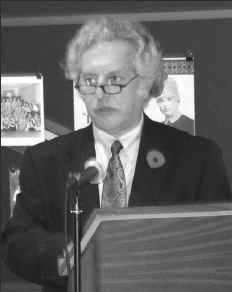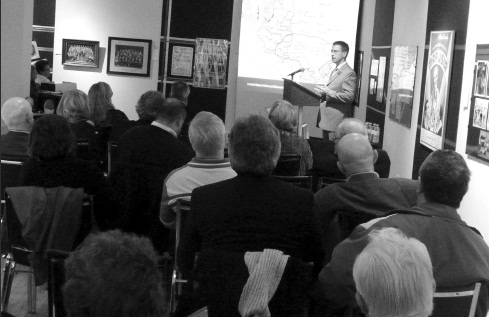Winnipeg Hosts
Conference on Ukrainians in Canada during WWII
A group of scholars
met in Winnipeg on November 11–12, 2011 to examine issues related to Ukrainian
Canadians and the Second World War. The gathering was a joint initiative of the
Kule Ukrainian Canadian Studies Centre at CIUS, the Centre for Ukrainian
Canadian Studies at the University of Manitoba, and the Oseredok
Ukrainian Cultural and Educational Centre in Winnipeg. Additional financial
support was provided by the Wasyl Topolnicki Memorial Fund and the University
of Manitoba’s Department of German and Slavic Studies.
The
well-attended event featured ten presenters from various parts of Canada who
addressed a wide range of topics that stimulated lively discussion, engaging
the audience and session chairs alike.
The
conference was introduced by Jars Balan (CIUS Kule Centre) with a recitation of
a 1903 poem by the pioneer-era community activist Michael Gowda, who argued in
his work that Ukrainian immigrants would only be recognized as fully “Canadian”
once they had fought and shown readiness to die for their adopted country. It
was this notion of the need to make a “blood sacrifice” that partly inspired
the title of the conference: “Becoming Canadian: Ukrainian Canadians and the
Second World War.”
The
first session opened with a presentation by Orest Zakydalsky (UCRDC) about oral
interviews with Ukrainian-Canadian service personnel held by the Ukrainian
Canadian Research and Documentation Centre in Toronto. Although the collection
is small (37 interviews) and not wholly representative, it nonetheless provides
some revealing insights into the motives and experiences of those who joined
the Canadian Armed Forces. Dr. Serge Cipko (CIUS Kule Centre) followed with a
look at wartime coverage of Ukrainian Canadians in the Edmonton Journal
and the Edmonton Bulletin, noting that two organizations in particular -
the Ukrainian Labour-Farmer Temple Association and the Ukrainian Canadian
Committee - received considerable attention from the mainstream press. Other
articles of interest included death notices, obituaries, and wedding
announcements (among them reports of local Ukrainian women marrying Americans
stationed or working in the Edmonton area during the war years), as well as
accounts of the involvement of Ukrainians in all aspects of the war effort.
A
short Remembrance Day ceremony was held at 11:00 a.m., hosted by Borys Gengalo,
a former major in the Canadian Militia. The commemoration featured a video
presentation about the participation of Canadian forces in conflicts and
peacekeeping duties since WWI; a reading of a memoiristic sketch describing the
experiences of a Winnipeg veteran named Joseph Malyna, who sought
unsuccessfully to join the elite “Devil’s Brigade”; and the recitation of a
special prayer composed for Ukrainian-Canadian troops by the Rev. Semen Sawchuk
while he served as a chaplain in the Canadian Army.
The
second session dealt with “the war before the war.” Dr. Myroslav Shkandrij
(University of Manitoba) examined events in Carpatho-Ukraine in 1938–39. He
noted the huge expectations of Ukrainians in Canada and elsewhere in the
diaspora that this tiny territory would serve as the nucleus of a future
Ukrainian State, as well as the general willingness of Western politicians and
pundits to accept the legitimacy of this fledgling autonomous territory before
it was militarily suppressed. Jars Balan then discussed how the image of the
Soviet Union evolved in the course of the 1930s from that of “Red Scare” to the
friendly “embrace of the Russian Bear.” Using stories drawn from the
English-Canadian press, he showed how with the help of skilful propaganda and
the growing threat posed by Nazi Germany and Imperial Japan, the image of
Joseph Stalin and his Bolshevik regime gradually turned from that of a menace to
Western democracies into that of a lesser evil, setting the stage for the view
of The Kremlin as a trusted ally during WWII.
 The
third session put a distinctly human face on the War. Suzanne Holyck-Hunchuck
(independent scholar, Ottawa) spoke about “Three Brothers in Service,” basing
her presentation on her own family history, supplemented with contextual
research. Peter Melnycky (Alberta Culture and Community Services) then focused
on Alberta Ukrainians decorated for distinguished service in the Royal Canadian
Air Force. His talk included the story of Russell Bannock (born Slawko Bahniuk
in Edmonton in 1919), one of Canada’s most decorated but largely unrecognized
wartime pilots. He also shared excerpts from the poignant correspondence
between another Alberta airman and his parents back home, in which the former
made a conscious effort to write in Ukrainian even though his grasp of the
language was imperfect.
The
third session put a distinctly human face on the War. Suzanne Holyck-Hunchuck
(independent scholar, Ottawa) spoke about “Three Brothers in Service,” basing
her presentation on her own family history, supplemented with contextual
research. Peter Melnycky (Alberta Culture and Community Services) then focused
on Alberta Ukrainians decorated for distinguished service in the Royal Canadian
Air Force. His talk included the story of Russell Bannock (born Slawko Bahniuk
in Edmonton in 1919), one of Canada’s most decorated but largely unrecognized
wartime pilots. He also shared excerpts from the poignant correspondence
between another Alberta airman and his parents back home, in which the former
made a conscious effort to write in Ukrainian even though his grasp of the
language was imperfect.
At
the last session of the first day, Andrij Makuch (CIUS Kule Centre) spoke about
the effect of the 1939 Molotov-Ribbentrop Pact, which forced the
Ukrainian-Canadian pro-communist Left to do a complete about-face from the
“United Front” against fascism that it had been promoting since the mid-1930s.
Needless to say, this put Soviet supporters in an incredibly awkward and
dangerous position. He was followed by Jody Perrun (Royal Military College),
who looked at “The War within the War” between Ukrainian Canadian nationalists
and communists in Winnipeg from 1939 and 1945, basing his observations on research
for his doctoral dissertation.
 Participants
reconvened after dinner for a screening of the 1943 Hollywood curiosity The
North Star. Boasting an impressive array of talent in front of and behind
the camera, the film ostensibly dealt with the impact of the Nazi invasion of
1941 on the inhabitants of a collective farm in Soviet Ukraine. In retrospect,
the film was an obvious showcase for the views of Hollywood’s leftist
sympathizers (among those involved in the production were the writer Lillian
Hellman and the composers Aaron Copland and Ira Gershwin), and it comes across
as a wooden, somewhat Soviet-style propaganda piece. Other highlights of the
evening’s theme-related program were a contemporary newsreel and a Donald
Duck cartoon ridiculing Hitler and the Nazis.
Participants
reconvened after dinner for a screening of the 1943 Hollywood curiosity The
North Star. Boasting an impressive array of talent in front of and behind
the camera, the film ostensibly dealt with the impact of the Nazi invasion of
1941 on the inhabitants of a collective farm in Soviet Ukraine. In retrospect,
the film was an obvious showcase for the views of Hollywood’s leftist
sympathizers (among those involved in the production were the writer Lillian
Hellman and the composers Aaron Copland and Ira Gershwin), and it comes across
as a wooden, somewhat Soviet-style propaganda piece. Other highlights of the
evening’s theme-related program were a contemporary newsreel and a Donald
Duck cartoon ridiculing Hitler and the Nazis.
The
sessions on the second day of conference consisted of longer presentations.
Roman Yereniuk (Centre for Ukrainian Canadian Studies, University of Manitoba)
started off with a detailed description of the Ukrainian chaplaincies in the
Canadian Forces during WWII. A total of seven Ukrainian clergymen, four
Orthodox and three Catholic, served in this capacity, all of them behind the
lines and toward the end of the War. They were especially active during
demobilization.
The
final presentation was delivered by Thomas Prymak (Chair of Ukrainian Studies,
University of Toronto), who spoke about Gabrielle Roy’s “Steven,” a prominent
figure in her posthumously published memoir, Enchantment and Sorrow. Dr.
Prymak sensitively documented the love affair between the Manitoba-born Roy and
the Alberta-born Ukrainian Canadian Stephen Davidovich, who met in England on
the eve of WWII. The intense romance was shattered by the sudden and
unexplained disappearance of Davidovich, an operative for the Organization of Ukrainian
Nationalists who was given a secret assignment in Europe. Things would never be
the same once he returned to England. Dr. Prymak had been tracing the contours
of this story since the 1980s, when he was working on his book Maple Leaf
and Trident, and his thoroughly researched and moving tale was very well
received by the audience.
Final
comments were offered by Sophia Kachor (Oseredok), who noted that
competing “nationalist” and “Canadian” threads often appeared in the
presentations. As for the question of whether the conference had attained its
objective of stimulating new research on Ukrainian Canadians and the Second
World War, she suggested that “time will tell,” but that this event had
demonstrated considerable interest and a remarkable level of knowledge about
the field.
CIUS Press Release
PHOTOS
1
- Peter Melnycky (Alberta Culture and Community
Services) revealing little-known facts about Alberta Ukrainians in the Royal
Canadian Air Force
2
- Dr. Jody Perrun (Royal Military College) speaking
about Ukrainian Canadian nationalists and communists in Winnipeg during WWII;
 The
third session put a distinctly human face on the War. Suzanne Holyck-Hunchuck
(independent scholar, Ottawa) spoke about “Three Brothers in Service,” basing
her presentation on her own family history, supplemented with contextual
research. Peter Melnycky (Alberta Culture and Community Services) then focused
on Alberta Ukrainians decorated for distinguished service in the Royal Canadian
Air Force. His talk included the story of Russell Bannock (born Slawko Bahniuk
in Edmonton in 1919), one of Canada’s most decorated but largely unrecognized
wartime pilots. He also shared excerpts from the poignant correspondence
between another Alberta airman and his parents back home, in which the former
made a conscious effort to write in Ukrainian even though his grasp of the
language was imperfect.
The
third session put a distinctly human face on the War. Suzanne Holyck-Hunchuck
(independent scholar, Ottawa) spoke about “Three Brothers in Service,” basing
her presentation on her own family history, supplemented with contextual
research. Peter Melnycky (Alberta Culture and Community Services) then focused
on Alberta Ukrainians decorated for distinguished service in the Royal Canadian
Air Force. His talk included the story of Russell Bannock (born Slawko Bahniuk
in Edmonton in 1919), one of Canada’s most decorated but largely unrecognized
wartime pilots. He also shared excerpts from the poignant correspondence
between another Alberta airman and his parents back home, in which the former
made a conscious effort to write in Ukrainian even though his grasp of the
language was imperfect. Participants
reconvened after dinner for a screening of the 1943 Hollywood curiosity The
North Star. Boasting an impressive array of talent in front of and behind
the camera, the film ostensibly dealt with the impact of the Nazi invasion of
1941 on the inhabitants of a collective farm in Soviet Ukraine. In retrospect,
the film was an obvious showcase for the views of Hollywood’s leftist
sympathizers (among those involved in the production were the writer Lillian
Hellman and the composers Aaron Copland and Ira Gershwin), and it comes across
as a wooden, somewhat Soviet-style propaganda piece. Other highlights of the
evening’s theme-related program were a contemporary newsreel and a Donald
Duck cartoon ridiculing Hitler and the Nazis.
Participants
reconvened after dinner for a screening of the 1943 Hollywood curiosity The
North Star. Boasting an impressive array of talent in front of and behind
the camera, the film ostensibly dealt with the impact of the Nazi invasion of
1941 on the inhabitants of a collective farm in Soviet Ukraine. In retrospect,
the film was an obvious showcase for the views of Hollywood’s leftist
sympathizers (among those involved in the production were the writer Lillian
Hellman and the composers Aaron Copland and Ira Gershwin), and it comes across
as a wooden, somewhat Soviet-style propaganda piece. Other highlights of the
evening’s theme-related program were a contemporary newsreel and a Donald
Duck cartoon ridiculing Hitler and the Nazis.